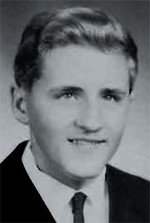Clipper Chatter
| Forum: Member Stories | |||||
|
|||||
|
Christopher Newman
 Posts: 28 View Profile |
"It's ALL fresh, hon" Posted Thursday, February 9, 2012 12:30 PM I remember Connolly's Restaurant, located on Pier 5, Pratt Street. I am sure that many of those who read this story will have all sorts of memories about the pale green metal building that was famous for its crab cakes, oysters, seafood platters, the 22-ounce frosted glasses of beer and the "sprightly", somewhat sassy waitresses. (It has always been my religious belief that the Connolly waitresses came from South Baltimore - rather than our East Baltimore.) The waitresses did not have much time for the pleasantries experienced between customers and servers at the more upscale restaurants like Miller Brothers on Fayette Street, Shellhase's on Howard Street, Hasslinger's (later to be the Chesapeake Restaurant) on North Charles Street and Haussner's on Eastern Avenue. All four restaurants began as strictly German restaurants. When Connolly's was at its peak it was open around the clock and it wasn't uncommon for 600-700 diners to be served on a summer weekend evening. Imagine the "old time" Baltimore harbour aroma of 10 to 15 bushels of blue crab being steamed in the Connolly kitchen on their busiest days. Mix this with the clanking sounds coming from the shipyards, truckloads of fresh produce being unloaded and the scent of spices coming from McCormick's. During the later evening hours the sounds of George Jones, Kitty Wells, and Patsy Cline could be heard coming from the large Country Music "Palace" which was located at the corner of Light and Pratt Streets. On the weekends the parking lot was filled with pick-up trucks, motorcycles, and, of course, a few turquoise and cream coloured Chevrolets. In a story written by Frederick Rasmussen, Sun reporter, July 27, 2008, Robert Cottom, a Baltimore resident, while dining at Connolly's with his wife recalled: "One evening some young, toney and ignorant Washingtonians sat next to us. Clearly out of place in Connolly's. They looked around and gazed upon our steamed crabs with an expression that said, 'How disgustingly provincial.'" Cottom went on to say. "The waitress came over, in her Fifties retro black dress, and they asked what was fresh?" "The waitress tapped her foot, cracked her gum and without looking up from her pad dismissed all pretension with a flat, 'It's ALL fresh, hon'". And it was all fresh ... and all fried. This was long before broiled crab cakes, Oysters Rockefeller and "Chardonnay" began to intrude upon Baltimore's traditional fried crab cake, steamed crabs, raw oysters on the half shell, or a fried oyster sandwich - and a pitcher or two of National Bohemian or Gunther beer, both locally brewed. Connolly's "hard fry" was unique and delicious. Put a fat "Baltimore crab cake" in an already steamed blue crab shell, dip and cover it in self-rising flour, deep fry and serve! The fried oyster sandwich was one of my favorites... large Chesapeake Bay oysters, lightly breaded and quickly fried in butter, served with a horseradish cocktail sauce on crackers or bread of your choice. Oysters were only served in Baltimore restaurants, from October through April, when the Bay and seaside waters were cooling. In December and January my father stored our oysters in the outside cellar-way; they remained fresh for a week to 10 days. I have never quite conquered the "art of oyster shucking" but it remains a lifetime goal! Stabbing yourself with an oyster knife, while holding a salty oyster, is a very unpleasant experience. Thomas J. Connolly opened his restaurant on Pratt Street in 1921. He had previously been a partner in the old R. J. McAllister seafood business. Connolly, who was very conscientious about seafood freshness, made regular visits, often weekly, to Crisfield and Saint Michaels on Maryland's Eastern Shore for oysters, crab, fish and watermelons. He made his trips aboard the William J. Brennan oyster boat. I remember the boat well, often docked off Pratt Street near Connolly's, filled with large watermelons and other produce. After his death in 1961, his son Sterling L. Connolly and his wife, Naomi, took over the management of the restaurant for the next 30 years. Connolly's restaurant was often loud, crowded and uncomfortable. The interior of the restaurant was almost as aesthetically offensive as the exterior - but customers kept coming because Connolly's was an old, trusted friend and the fare was reasonable. Connolly's Restaurant was a "hard fry" - as "Baltimore" as (Mayor) William Donald Schaefer - who dined there with his mother, Tululu Irene Schaefer, every Sunday evening. Many nationally known celebrities, between 1921 and 1991, would enjoy their first crab cake at Connolly's. F. Scott Fitzgerald (Francis Scott Key Fitzgerald), one of the great American writers of the 20th century, second cousin to the writer of our National Anthem, was seen in Connolly's with his wife, Zelda, in the mid to late 1930's. The Fitzgeralds lived a fast and lavish lifestyle in Europe and the United States during the 1920's but returned to Baltimore in 1932 where they lived at La Paix, a large, decorative Victorian house located between Baltimore City and Towson, Maryland (Rodgers Forge). In 1933 they moved to 1307 Park Avenue, Bolton Hill, and later Fitzgerald moved to the Cambridge Arms Apartments opposite the Johns Hopkins University Campus. (Zelda, during this time, was being treated for recurring bouts of mental illness at the Phipps Clinic and other Baltimore hospitals.) In reference to Zelda's continued decline Fitzgerald wrote: "...there is no good end in sight. She is very sweet and tragic. For the majority of creative people life is a pretty mean trick." From his apartment window, at Charles and 34th Streets in north Baltimore, F. Scott Fitzgerald could see a monument to his ancestor, Francis Scott Key. It was here that he finished the great novel, "Tender is the Night." In later writings Fitzgerald rejected the libertine existence of the roaring 1920's. F. Scott found strength in his Baltimore and Southern Maryland roots and the constant example of his father's impeccable Southern manners. In a letter to his daughter, Scottie, written in 1938, he stated that he never found anything to take the place of the old virtues of work and courage - and the old graces of courtesy and politeness. Fitzgerald died in 1940 and is buried at Saint Mary's Catholic Cemetery, in Rockville, Maryland. Connolly's closed its doors during the summer of 1991 to make way for the Christopher Columbus Center for Marine Research and Exploration. It was raining the day the demolition began ... both of the surviving Connolly ladies stood in the rain, under umbrellas, to watch the old green walls come down. "Longtime Baltimoreans said they were shocked and saddened to learn that the so-ugly-it's- beautiful eatery, where stars rubbed elbows with sailors, had finally succumbed to urban redevelopment." ...Reported by the Sunpapers at the time.
Christopher Wm. Newman February 9, 2012 |
||||
|
|||||

